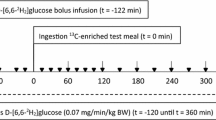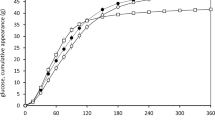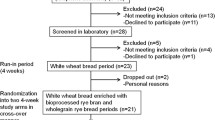Abstract
In the present study, a novel method of measuring the uptake of nutrients by 1H NMR spectroscopy was performed to determine dietary effects. Six pigs catheterized in the portal vein and mesenteric artery were fed breads made from whole-wheat grain (WWG), wheat aleurone flour (WAF; 19 % aleurone of bread) or rye aleurone flour (RAF; 15 % aleurone of bread) in a repeated 3 × 3 crossover design. Three meals were provided daily (at 0, 5 and 10 h), and each period comprised of 1 week. Portal and arterial blood samples were collected at fasting (−30 min) on day 4–7, and on day 7, pooled blood samples were collected at 0–2.5, 2.5–5, 5–7.5 and 7.5–10 h after first (0 h) daily meal. Using the arterial-venous difference and ANOVA–simultaneous component analysis, plasma betaine was found to accumulate during the experimental period. On day 7, plasma betaine concentrations was 20–40 % higher than when feeding the WAF diet compared with RAF and WWG (P = 0.001), whereas the content of betaine in the WAF diet was about twice as high. The arterial-venous difference showed a tendency (P = 0.078) for the diet–time interaction of betaine absorption in the absorption phases but there was no diet effect (P = 0.31), which indicates a steady-state absorption has been reached on day 7. Furthermore, high plasma betaine levels correlated with low plasma creatine of endogenous origin. In conclusion, the explorative method revealed that the plasma concentration and absorption of betaine were differentially modified by the diets.





Similar content being viewed by others
References
Slavin J (2004) Whole grains and human health. Nutr Res Rev 17(1):99–110
Mellen PB, Walsh TF, Herrington DM (2008) Whole grain intake and cardiovascular disease: a meta-analysis. Nutr Metab Cardiovasc Dis 18(4):283–290
Fardet A (2010) New hypotheses for the health-protective mechanisms of whole-grain cereals: what is beyond fibre? Nutr Res Rev 23(1):65–134
Bacic A, Stone BA (1981) Isolation and ultrastructure of aleurone cell-walls from wheat and barley. Aust J Plant Physiol 8(4–5):453–474
Hemery Y, Rouau X, Lullien-Pellerin V, Barron C, Abecassis J (2007) Dry processes to develop wheat fractions and products with enhanced nutritional quality. J Cereal Sci 46(3):327–347
Brouns F, Hemery Y, Price R, Anson NM (2012) Wheat aleurone: separation, composition, health aspects, and potential food use. Cri Rev Food Sci Nutr 52(6):553–568
Price RK, Keaveney EM, Hamill LL, Wallace JM, Ward M, Ueland P, McNulty H, Strain JJ, Parker MJ, Welch RW (2010) Consumption of wheat aleurone-rich foods increases fasting plasma betaine and modestly decreases fasting homocysteine and LDL-cholesterol in adults. J Nutr 140:2153–2157
Finkelstein JD, Martin JJ (1984) Methionine metabolism in mammals—distribution of homocysteine between competing pathways. J Biol Chem 259(15):9508–9513
Kharbanda KK, Rogers DD, Mailliard ME, Siford GL, Barak AJ, Beckenhauer HC, Sorrell MF, Tuma DJ (2005) A comparison of the effects of betaine and S-adenosylmethionine on ethanol-induced changes in methionine metabolism and steatosis in rat hepatocytes. J Nutr 135(3):519–524
Olthof MR, Verhoef P (2005) Effects of betaine intake on plasma homocysteine concentrations and consequences for health. Curr Drug Metab 6(1):15–22
Craig SAS (2004) Betaine in human nutrition. Am J Clin Nutr 80(3):539–549
Wang ZN, Klipfell E, Bennett BJ, Koeth R, Levison BS, Dugar B, Feldstein AE, Britt EB, Fu XM, Chung YM, Wu YP, Schauer P, Smith JD, Allayee H, Tang WHW, DiDonato JA, Lusis AJ, Hazen SL (2011) Gut flora metabolism of phosphatidylcholine promotes cardiovascular disease. Nature 472(7341):57–82
Bertram HC, Bach Knudsen KE, Serena A, Malmendal A, Nielsen NC, Frette XC, Andersen HJ (2006) NMR-based metabonomic studies reveal changes in the biochemical profile of plasma and urine from pigs fed high-fibre rye bread. Br J Nutr 95(5):955–962
Bertram HC, Malmendal A, Nielsen NC, Straadt IK, Larsen T, Bach Knudsen KE, Laerke HN (2009) NMR-based metabonomics reveals that plasma betaine increases upon intake of high-fiber rye buns in hypercholesterolemic pigs. Mol Nutr Food Res 53(8):1055–1062
Moazzami AA, Zhang JX, Kamal-Eldin A, Aman P, Hallmans G, Johansson JE, Andersson SO (2011) Nuclear magnetic resonance-based metabolomics enable detection of the effects of a whole grain rye and rye bran diet on the metabolic profile of plasma in prostate cancer patients. J Nutr 141(12):2126–2132
Fardet A, Canlet C, Gottardi G, Lyan B, Llorach R, Remesy C, Mazur A, Paris A, Scalbert A (2007) Whole-grain and refined wheat flours show distinct metabolic profiles in rats as assessed by a H-1 NMR-based metabonomic approach. J Nutr 137(4):923–929
Graham SF, Hollis JH, Migaud M, Browne RA (2009) Analysis of betaine and choline contents of aleurone, bran, and flour fractions of wheat (Triticum aestivum L.) Using H-1 nuclear magnetic resonance (NMR) spectroscopy. J Agric Food Chem 57(5):1948–1951
Smilde AK, Jansen JJ, Hoefsloot HCJ, Lamers RJAN, van der Greef J, Timmerman ME (2005) ANOVA-simultaneous component analysis (ASCA): a new tool for analyzing designed metabolomics data. Bioinformatics 21(13):3043–3048
Jansen JJ, Hoefsloot HCJ, van der Greef J, Timmerman ME, Westerhuis JA, Smilde AK et al (2005) ASCA: analysis of multivariate data obtained from an experimental design. J Chemom 19(9):469–481
Yde CC, Westerhuis JA, Bertram HC, Bach Knudsen KE (2011) Application of NMR-based metabonomics suggested a relationship between betaine absorption and elevated creatine plasma concentrations in catheterised sows. Br J Nutr 107:1603–1615
Le Gall M, Serena A, Jorgensen H, Theil PK, Bach Knudsen KE (2009) The role of whole-wheat grain and wheat and rye ingredients on the digestion and fermentation processes in the gut—a model experiment with pigs. Br J Nutr 102(11):1590–1600
Le Gall M, Eybye KL, Bach Knudsen KE (2010) Molecular weight changes of arabinoxylans of wheat and rye incurred by the digestion processes in the upper gastrointestinal tract of pigs. Livest Sci 134(1–3):72–75
Theil PK, Jorgensen H, Serena A, Hendrickson J, Bach Knudsen KE (2011) Products deriving from microbial fermentation are linked to insulinaemic response in pigs fed breads prepared from whole-wheat grain and wheat and rye ingredients. Br J Nutr 105:373–383
Kissmeyernielsen A, Jensen SA, Munck L (1985) The botanical composition of rye and rye milling fractions determined by fluorescence spectrometry and amino-acid composition. J Cer Sci 3(3):181–192
Anson NM, van den Berg R, Havenaar R, Bast A, Haenen GRMM (2008) Ferulic acid from aleurone determines the antioxidant potency of wheat grain (Triticum aestivum L.). J Agric Food Chem 56(14):5589–5594
Jorgensen H, Serena A, Theil PK, Engberg RM (2010) Surgical techniques for quantitative nutrient digestion and absorption studies in the pig. Livest Sci 133(1–3):57–60
Meiboom S, Gill D (1958) Modified spin-echo method for measuring nuclear relaxation times. Rev Sci Instrum 29(8):688–691
Rerat AA, Vaissade P, Vaugelade P (1984) Absorption kinetics of some carbohydrates in conscious Pigs.2. quantitative aspects. Br J Nutr 51(3):517–529
Keun HC, Ebbels TMD, Bollard ME, Beckonert O, Antti H, Holmes E, Lindon JC, Nicholson JK (2004) Geometric trajectory analysis of metabolic responses to toxicity can define treatment specific profiles. Chem Res Toxicol 17(5):579–587
Littell RC, Milliken GA, Storup WW (1996) SAS (R) System for mixed models. SAS Institute Inc., Cary
Schwab U, Alfthan G, Aro A, Uusitupa M (2011) Long-term effect of betaine on risk factors associated with the metabolic syndrome in healthy subjects. Eur J Clin Nutr 65(1):70–76
Kettunen H, Peuranen S, Tiihonen K, Saarinen M (2001) Intestinal uptake of betaine in vitro and the distribution of methyl groups from betaine, choline, and methionine in the body of broiler chicks. Comp Biochem Physiol A Mol Integr Physiol 128(2):269–278
Kettunen H, Tiihonen K, Peuranen S, Saarinen MT, Remus JC (2001) Dietary betaine accumulates in the liver and intestinal tissue and stabilizes the intestinal epithelial structure in healthy and coccidia-infected broiler chicks. Comp Biochem Physiol A Mol Integr Physiol 130(4):759–769
Schwahn BC, Hafner D, Hohlfeld T, Balkenhol N, Laryea MD, Wendel U (2003) Pharmacokinetics of oral betaine in healthy subjects and patients with homocystinuria. Br J Clin Pharmacol 55(1):6–13
Atkinson W, Elmslie J, Lever M, Chambers ST, George PM (2008) Dietary and supplementary betaine: acute effects on plasma betaine and homocysteine concentrations under standard and postmethionine load conditions in healthy male subjects. Am J Clin Nutr 87(3):577–585
Ross AB, Bruce SJ, Blondel-Lubrano A, Oguey-Araymon S, Beaumont M, Bourgeois A, Nielsen-Moennoz C, Vigo M, Fay LB, Kochhar S, Bibiloni R, Pittet AC, Emady-Azar S, Grathwohl D, Rezzi S (2011) A whole-grain cereal-rich diet increases plasma betaine, and tends to decrease total and LDL-cholesterol compared with a refined-grain diet in healthy subjects. Br J Nutr 105(10):1492–1502
Yde CC, Bertram HC, Bach Knudsen KE (2010) NMR-based metabonomics reveals distinct metabolic profiles of plasma from sows after consumption of diets with contrasting dietary fibre levels and composition. Livest Sci 133(1–3):26–29
Brosnan JT, Wijekoon EP, Warford-Woolgar L, Trottier NL, Brosnan ME, Brunton JA, Bertolo RFP (2009) Creatine synthesis is a major metabolic process in neonatal piglets and has important implications for amino acid metabolism and methyl balance. J Nutr 139(7):1292–1297
Acknowledgments
The European Commission in the Communities Sixth Framework Programme, Project HEALTHGRAIN (FOOD-CT-2005-514008) is greatly acknowledged for financial support. The Danish Agency for Science, Technology and Innovation is thanked for co-funding the PhD project for Christian Clement Yde. Jeroen Jasper Jansen was financed by the Netherlands Metabolomics Centre (NMC), which is a part of the Netherlands Genomics Initiative/Netherlands Organisation for Scientific Research. There is no conflict of interest.
Author information
Authors and Affiliations
Corresponding author
Rights and permissions
About this article
Cite this article
Yde, C.C., Jansen, J.J., Theil, P.K. et al. Different metabolic and absorption patterns of betaine in response to dietary intake of whole-wheat grain, wheat aleurone or rye aleurone in catheterized pigs. Eur Food Res Technol 235, 939–949 (2012). https://doi.org/10.1007/s00217-012-1825-5
Received:
Revised:
Accepted:
Published:
Issue Date:
DOI: https://doi.org/10.1007/s00217-012-1825-5




